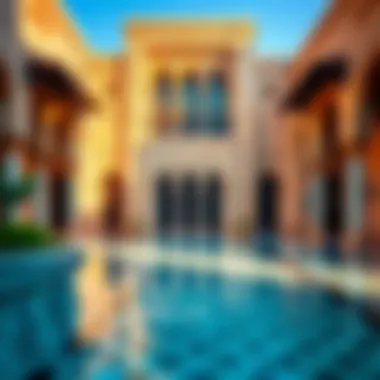Ajman vs. Sharjah: In-Depth Comparison of Two Emirates


Intro
In the intricate tapestry of the United Arab Emirates, Ajman and Sharjah stand out not just geographically, but also in terms of their unique characteristics, lifestyles, and economic opportunities. Both emirates, while in close proximity—just a stone's throw from each other—offer remarkably different experiences and options for investors, homeowners, and expatriates alike. This article aims to serve as a compass in navigating the complexities of these two vibrant locales, dissecting their market trends, investment strategies, cultural nuances, and more.
As we delve into the heart of Ajman and Sharjah, it’s essential to grasp the current dynamics at play. Recognizing what these areas truly offer is pivotal, especially for those keen on making informed choices in real estate or seeking the right educational settings for their families.
Why Compare Ajman and Sharjah?
When looking at Ajman and Sharjah, it’s not just a matter of geography; it’s about understanding two different worlds within the same region. Ajman is known for its serene beaches and smaller population, presenting a laid-back atmosphere and affordable living options. Conversely, Sharjah, with its rich cultural heritage and a bustling city vibe, often draws those eager for cultural engagements and a broader range of amenities. By comparing them, potential investors and residents can effectively identify which emirate aligns better with their aspirations and lifestyle needs.
Prologue
In the Gulf region, the United Arab Emirates is known for its numerous emirates, each with its distinctive flavor. Among the most notable are Ajman and Sharjah, neighboring emirates that often find themselves compared. This article sheds light on their unique traits and serves as a comprehensive guide for investors, homeowners, and expatriates who seek to understand these two distinct regions.
The importance of this comparison cannot be understated. For potential buyers and residents, grasping the nuances of Ajman and Sharjah can influence decisions about living arrangements, investments, and lifestyle choices. With Ajman's rising popularity due to affordable living costs and Sharjah’s robust cultural ethos, understanding what each emirate has to offer is crucial.
Ajman, the smallest emirate by land area, boasts beautiful coastlines and burgeoning economic zones. Meanwhile, Sharjah, known as the cultural capital of the UAE, offers a rich history and a plethora of educational institutions. These dimensions—economic growth, cultural significance, property market dynamics, and lifestyle amenities—each play an instrumental role in decision-making for potential stakeholders.
Consider the following aspects:
- Economic Conditions: Assessing job markets, business opportunities, and growth potential is essential for investors looking to plant roots in either emirate.
- Cultural Differences: Understanding the cultural landscape is fundamental for expatriates who wish to integrate smoothly into the community.
- Real Estate Dynamics: Navigating the property markets in both regions can help homeowners make informed investments.
- Lifestyle Amenities: A comparison of recreational facilities and community life can significantly affect day-to-day experiences.
By diving deep into these topics, this article aims to furnish readers with insightful information, enabling informed choices. Ultimately, whether one is drawn to Ajman’s charm or Sharjah’s heritage, understanding these emirates' individual attributes is the key to making the right decision.
Geographical Overview
Understanding the geographical landscape of Ajman and Sharjah is crucial for anyone contemplating a move or investment in these emirates. The geographical aspects not only influence climate conditions but also dictate accessibility, economic prospects, and lifestyle opportunities in both areas. In considering a location, prospective homeowners and investors might want to weigh, for example, proximity to major highways, availability of public transit, and how the natural environment contributes to their quality of life. Thus, this section aims to shed light on both the location and accessibility as well as the climate and natural landscape of Ajman and Sharjah.
Location and Accessibility
Ajman is nestled along the western shoreline of the UAE, while Sharjah sits adjacent to it on the northern side, creating a significant interdependence between the two. Ajman’s location provides convenient access to the emirate of Dubai, just a short drive away. This easy connectivity bolsters Ajman’s appeal as a residential area for those who work in Dubai but prefer a quieter lifestyle.
Moreover, Ajman has been ramping up its road infrastructure, with major highways linking it efficiently to Dubai and Sharjah. The Sheikh Mohammed Bin Zayed Road connects Ajman to key cities in the emirates, making commuting much smoother. For those considering investing in properties, being near these primary thoroughfares can be an attractive proposition, considering future appreciation in property values.
Climate and Natural Landscape
Weather-wise, both Ajman and Sharjah experience a similar desert climate, characterized by hot summers and mild winters. The scorching heat from June to September can reach upwards of 50°C, which can be more bearable near the coast due to the refreshing sea breeze. The winter months are certainly a treat, with temperatures ranging from 14°C to 24°C, making it an ideal time for outdoor activities and community events.
The natural landscape includes breathtaking beaches with golden sands in Ajman and vibrant greenery in parts of Sharjah. Ajman is often celebrated for its shoreline, which stretches along the Arabian Gulf, offering a plethora of leisure activities for families and individuals alike. On the other hand, Sharjah boasts a unique blend of natural and urban attractions, including parks and cultural sights like the Al Qasba and the Sharjah Corniche.
"The geographic allure of these two emirates is certainly one of their strong points, offering a blend of urban conveniences and natural beauty."
In summary, the geographical characteristics of Ajman and Sharjah not only define their landscapes but also draw a clear picture of their accessibility. Understanding these factors will help investors and residents make informed choices that align with their lifestyles and expectations. Mindfully considering the locale can paint a richer understanding of what each emirate has to offer.
Historical Context
Understanding the historical backdrop is pivotal in grasping how both Ajman and Sharjah have shaped their identities over the years. The stories and events that unfolded in these emirates not only impact their current socio-economic landscapes but also provide invaluable insights for investors, homeowners, and expatriates considering a stake in these regions. By examining the historical context, one can better appreciate the cultural nuances, community dynamics, and governance structures that influence life in both Ajman and Sharjah today.
Foundational History of Ajman
Ajman, the smallest emirate, has a rich tapestry of history woven through maritime trade and traditional lifestyles. It was established in the early 18th century, primarily as a coastal town focused on fishing and pearling. The emirate’s strategic location along the Arabian Gulf allowed it to flourish as a trading post.
Historically, Ajman was inhabited by the Al Nuaimi tribe, known for their strong maritime skills. The emirate evolved, navigating through various challenges from British colonial influences to Gulf Wars, all while preserving its cultural legacy. The establishment of the Ajman Free Zone in 1988 marked a significant turning point, encouraging foreign investment and modernizing its economic base. Today, Ajman’s history instructs its growth, blending tradition with modernity to create a unique atmosphere that attracts new residents and businesses alike.
Sharjah's Historical Development
Sharjah stands out with its rich cultural heritage, often regarded as the cultural capital of the UAE. Its history dates back to the 5th century, making it one of the oldest emirates in the region. Sharjah was originally a fishing settlement and gradually transformed into a hub for trade and spices due to its proximity to key maritime routes.
The rather tumultuous period of the 20th century saw Sharjah navigate through the same colonial pressures that affected other emirates. However, its commitment to education and the arts started developing in the late 1970s, propelling it into the spotlight.
In 1998, Sharjah was named the Cultural Capital of the Arab World by UNESCO, a title that reflects its dedication to preserving Arab heritage while embracing modernity. The establishment of cultural institutions like the Sharjah Art Museum and Al Qasba, showcases its vision of a diverse and modern emirate, energizing the local community and drawing in tourists.
"Investors looking to connect with a vibrant community will find that the historical foundations of Ajman offer a contrasting yet complementary perspective to Sharjah's rich cultural legacies."
Both Ajman and Sharjah exhibit how history plays a foundational role in their development paths. Their journey from fishing and trading villages to modern emirates showcases resilience and adaptability, vital for anyone considering to live, work, or invest there.
Economic Landscape
The economic landscape serves as the backbone of any region, significantly influencing its development and attractiveness to investors and residents alike. In this article, we examine the economic landscape of Ajman and Sharjah, two Emirates with unique offerings. Understanding their economic drivers and key industries not only provides insight into potential investment opportunities but also informs lifestyle choices for expatriates and locals. Knowing the economic strengths and weaknesses of each region is crucial for any discerning investor, homeowner, or developer. This overview will highlight contemporary economic conditions while touching on factors like market trends, demographics, and governmental initiatives that shape each Emirate’s economy.
Ajman's Economic Drivers
Ajman has a relatively small but rapidly growing economy, primarily driven by a few key sectors. The Emirate holds a strategic geographical advantage as it sits on the Arabian Gulf, attracting trade and business. One of the significant economic drivers in Ajman is its focus on trade and commerce. The Ajman Free Zone has become a popular destination for foreign investors looking for tax exemptions and business-friendly regulations. This area appeals especially to small and medium-sized enterprises looking to tap into UAE's vibrant market without the heftier costs found in larger Emirates.
Key Economic Highlights of Ajman:
- Tourism and Hospitality: Ajman has been steadily gaining traction as a tourist destination, with luxurious resorts and hotels lining its coastline. This has led to growth in the hospitality sector.
- Manufacturing: The manufacturing sector is another vital part of Ajman's economy, with an emphasis on building materials, textiles, and food production industries.
- Real Estate: Ajman's property market is becoming increasingly appealing due to affordability compared to its neighbors. This poses a valuable opportunity for investors interested in residential or commercial properties.
In light of Ajman's economic drivers, potential investors may find attractive propositions in sectors positioned for growth. The government's initiatives in enhancing infrastructure and providing incentives for new businesses present a strong case for exploring opportunities within this Emirate.
Sharjah's Key Industries
Sharjah, often regarded as the cultural heart of the UAE, boasts a diverse economy underpinned by various key industries that symbolize its developmental ethos. One of the most significant sectors is cultural tourism, which draws visitors to its many museums, art galleries, and festivals. This sector enriches the local economy while promoting educational tourism.
Core Industries in Sharjah:
- Education: Home to many universities and educational institutions, Sharjah invests deeply in knowledge and skills development. This focus lays a solid foundation for business innovation and workforce specialization.
- Manufacturing and Industry: Sharjah has strategically positioned itself as a hub for manufacturing; with its Sharjah Airport International Free Zone, it attracts businesses focused on industrial activities ranging from petrochemicals to logistics.
- Media and Publishing: Sharjah has a vibrant media scene, underpinned by various publishing houses, making noteworthy contributions to the local economy.
- Healthcare: Investing in healthcare facilities and initiatives has placed Sharjah on the lists for medical tourism, drawing patients seeking specialized treatments.
In summary, Sharjah's diversified economy provides a robust platform for further growth and investment. The Emirate’s incorporation of education and technology into its different sectors ensures a knowledgeable and capable workforce, advancing its economic aspirations.


"Understanding the economic landscape is essential for making informed decisions in Ajman and Sharjah—both emirates offer distinctive advantages, attracting varied investments and lifestyles."
In closing, each Emirate presents a unique set of economic drivers that cater to different markets. Investors and homeowners should weigh the benefits of both Ajman and Sharjah to find the best fit for their personal and professional objectives.
Real Estate Market Dynamics
In the realm of investment and habitation, understanding real estate market dynamics between Ajman and Sharjah emerges as a pivotal element of this discussion. Each emirate offers a unique landscape of opportunities, shaped by their individual approaches to urban development, economic incentives, and lifestyle preferences. For potential investors, homeowners, and expatriates weighing their options, knowing the trends within these markets aids in making informed choices. Moreover, discerning the nuances between Ajman’s and Sharjah’s properties can illuminate which location might better suit one’s lifestyle or investment goals.
Ajman's Real Estate Trends
Ajman's real estate sector has been experiencing a notable shift, demonstrating both growth and resilience. The coastline of Ajman has become particularly attractive, leading to a surge in demand for beachfront properties. These areas are though relatively new in terms of development when compared to more established emirates.
- Affordability: Home prices in Ajman tend to be lower than those in Dubai and Abu Dhabi, making it an appealing option for first-time buyers or investors looking for budget-friendly opportunities.
- Government Initiatives: Recent policies aimed at boosting foreign investment, including changes to ownership laws and incentives for developers, are fostering growth and expanding the residential property options available.
- Emerging Developments: Projects like Ajman One and the Ajman Marina are revitalizing the market, offering new residential options that focus on modern living spaces paired with family-oriented amenities.
Despite these positive trends, the market in Ajman can be subject to fluctuations influenced by broader economic conditions and real estate market dynamics in the region.
Sharjah's Property Market Overview
Sharjah's real estate market is a mixed bag—it shows stability combined with a tangible potential for growth. The emirate has historically attracted families and long-term expatriates looking for a more conservative lifestyle while still being integrated into the hustle of the UAE's rapid development.
- Cultural Appeal: Sharjah is known for its rich cultural heritage and commitment to preserving its identity. This translates into residential options that reflect traditional architecture, appealing to those seeking a sense of community and historical significance.
- Housing Variety: The variety of properties ranges from luxurious villas to affordable apartments, catering to a diverse demographic. This flexibility allows buyers to choose what best suits their needs and financial capability.
- Educational Hub: With numerous educational institutions and a focus on family-friendly living, Sharjah’s residential areas are often sought out by families prioritizing their children's education.
- Property Regulations: The local government has also put in place regulations to ensure transparency and buyer protection, which can instill confidence for those considering real estate investments.
Overall, while both Ajman and Sharjah offer unique insights into the UAE’s real estate market, their different strategies reflect the diverse needs of their residents and investors. As these empires continue to develop, their respective real estate landscapes will likely evolve, paving the way for opportunities yet to emerge.
"Investing in real estate has always been viewed as a gateway to wealth creation; understanding local markets, like those of Ajman and Sharjah, could well be the key to that door."
For more extensive insights, you can refer to Wikipedia or browse through Britannica for historical contexts.
Cultural Perspectives
Cultural perspectives form the backbone of any society, and in the case of Ajman and Sharjah, they offer a rich tapestry of traditions, values, and identities that distinguish these two emirates. This section highlights the significance of cultural identities, showcasing how they not only influence social interactions but also play a vital role in shaping economic opportunities and lifestyle choices for both residents and visitors. Understanding these cultural nuances is key for potential investors and homeowners as they assess the vibrant social fabrics that define living in these locales.
Cultural Heritage of Ajman
Ajman's cultural heritage reflects the essence of its historical significance and the deep-rooted traditions of the Arabian Peninsula. The emirate is characterized by its old forts like the Ajman Fort, which stands as a witness to its past, embodying architectural sophistication that dates back centuries. The preservation of local handicrafts, like ghutras and kandoras, also illustrate Ajman's connection to its heritage.
In more recent years, Ajman has nurtured its cultural scene by hosting various art exhibitions and folklore events, which highlight the folk traditions of the emirate. The Ajman Museum presents artifacts that tell stories of the past, making it an essential stop for anyone looking to understand the essence of Ajman's identity. The cultural advancement initiatives mean that artists and artisans are being brought into the spotlight, further enriching the emirate’s colorful traditions.
"Ajman stands as a bridge between past and present, demonstrating that heritage can coexist with modernity."
Sharjah: The Cultural Capital
Sharjah is often heralded as the cultural capital of the UAE, demonstrating a profound commitment to the arts and preservation of heritage. With numerous museums, such as the Sharjah Art Museum, and vibrant cultural festivals, it has established a reputation that attracts visitors and scholars alike. The emirate is home to a rich array of cultural institutions, including the Sharjah International Book Fair, which showcases the importance of literature in the region.
Moreover, Sharjah's dedication to cultural initiatives is evident in its hosting of art fairs and exhibitions that promote local and international artists. The emirate's efforts in fostering education through cultural programs reinforce its identity as a center for learning and knowledge. Dhows, traditional wooden boats, can often be seen lining the Corniche, signifying the emirate’s deep connections to maritime heritage and its historical significance in trade.
In essence, Sharjah’s approach to culture is not just about showcasing tradition but is a continuous conversation between the old and new, making it a significant point of interest for investors, homeowners, and expatriates.
By understanding these cultural perspectives, one can appreciate the unique identities of Ajman and Sharjah, essential for making informed decisions regarding living, investing, or engaging with the rich histories of these emirates.
Lifestyle and Amenities
When discussing Ajman and Sharjah, it's crucial to factor in how lifestyle and amenities shape the living experience in these two emirates. Lifestyle encompasses more than just the basic needs—it reflects the quality of life, recreational opportunities, and social engagement available to residents and visitors. Understanding this aspect allows potential investors and homeowners to weigh what each emirate offers based on their personal preferences and family needs. The atmosphere in both Ajman and Sharjah encourages a communal vibe, but they differ in the specific amenities they provide.
Recreational Options in Ajman
Ajman boasts a relaxed ambiance, ideal for those looking to enjoy leisurely activities. One of the major highlights is Ajman's beautiful coastline. The emirate features extensive sandy beaches along the Arabian Gulf, such as Al Zorah Beach and Ajman Beach. Here, families and friends can partake in a range of activities, from sunbathing to beach sports.
In addition to the waterfront appeal, Ajman has parks and green spaces like Ajman Corniche, which not only enhances the urban landscape but also offers a tranquil retreat from the daily hustle. The corniche is dotted with cafes, making it a popular spot for picnics or evening strolls.
Moreover, the emirate hosts several sports facilities, including those for basketball and football. Individuals interested in more organized activities may find clubs offering martial arts, swimming, and more.
A unique feature of Ajman is its cultural festivals, which take place throughout the year. These events often include local food stalls, craft displays, and performances that showcase the emirate’s rich heritage.
Sharjah's Entertainment and Leisure Offerings
Sharjah takes the cake when it comes to blending culture with leisure. As the cultural capital of the UAE, Sharjah offers a range of attractions for those keen on both entertainment and education. Venues like the Sharjah Art Museum and the Sharjah Aquarium provide enriching experiences for families, enhancing understanding and appreciation of art and marine life, respectively.
Outdoor enthusiasts can enjoy the Al Majaz Waterfront, which comes alive with its stunning views and recreational activities ranging from kayaking to jogging paths. The proudly maintained Al Qasba, with its creek-side cafes and the iconic Eye of the Emirates, allows for a pleasant day out, complete with shopping.
For those who prefer indoor entertainment, Sharjah is home to several malls that feature international brands and local boutiques. Events like concerts and cultural exhibitions are often held here, appealing to a diverse audience.
Lastly, community events amplify the social fabric, encouraging participation in local traditions. Markets and festival celebrations often bring neighbors together, fostering an inviting atmosphere that reflects the emirate's strong sense of community.
The choice of lifestyle in both Ajman and Sharjah significantly impacts family well-being and social involvement, making it a key consideration when evaluating residential options.
Educational Infrastructure
In a rapidly developing region like the UAE, educational infrastructure plays a crucial role in shaping the future of its inhabitants. In the context of comparing Ajman and Sharjah, the educational facilities available can significantly influence decisions for families considering relocation or investors eyeing educational projects. This section dives into the education systems of both emirates, looking at how they cater not just to local nationals but also the ever-growing expatriate population. A robust educational infrastructure is essential not only for economic growth but also for the overall quality of life, as it bolsters the community's ability to thrive.
Schooling in Ajman
Ajman has been making strides in enhancing its educational offerings, understanding that good schools attract families. Several private and public schools operate within the emirate, providing diverse curricula like British, American, and Indian education systems. Many of these schools cater specifically to the expatriate community, who represent a sizeable portion of the student population.
- Infrastructure and Facilities: Schools in Ajman often boast modern facilities, with science labs, art studios, and sports complexes that encourage holistic development. The classrooms are designed to optimize learning, promoting a conducive environment for both teachers and students.
- Quality of Education: The quality of education in Ajman is recognized through various accreditations and inspections by relevant educational authorities. Schools often hire qualified teachers, many of whom come from internationally recognized institutions, ensuring a quality education.
- Accessibility: Additionally, schooling offers geographical convenience. Many families find that schools are within a short distamnce from their residences, adding to the appeal for those commuting on a daily basis.
Educational Institutions in Sharjah
Sharjah is often considered the cultural heart of the UAE, and its educational institutions reflect this distinction. The emirate boasts a range of educational establishments, from primary schools to specialized universities offering advanced degrees and vocational training programs.


- Diversity and Specialization: Educational institutions in Sharjah are known for their diversity, catering to various academic preferences. For instance, universities like the American University of Sharjah and the University City of Sharjah offer specialized programs in engineering, business, and arts.
- Government Support: The government places a strong emphasis on education, providing significant investments to develop infrastructure and enhance teaching quality. Various scholarships and funding programs are available, encouraging both nationals and expatriate students to pursue higher learning.
- Cultural Integration: Sharjah’s educational framework is not just about academia; it integrates cultural values into the curriculum. Students are encouraged to delve into the emirate's rich heritage, ensuring that while they are globally competent, they also remain rooted in their cultural identity.
Transportation and Connectivity
When considering a move or investment in either Ajman or Sharjah, the effectiveness of transportation and connectivity cannot be understated. These factors not only influence daily life experiences but also directly impact economic opportunities and overall attractiveness of an emirate to investors and homeowners alike. A well-structured transportation system facilitates seamless travel within and beyond the borders of Ajman and Sharjah, making them vital areas to explore.
Public Transport in Ajman
Ajman’s public transport system, while not as expansive as that of some larger cities, offers essential services that cater effectively to its residents and visitors. Buses provide the backbone of public transit, linking various key locations within the emirate at affordable rates. The Ajman bus network has seen gradual improvements in recent years, with strategic routes developed to connect key residential areas with commercial districts.
- Buses: These are the main mode of public transport with routes like the Ajman-Ras Al Khaimah line, which facilitates travel between emirates, enhancing interconnectivity.
- Taxis: Readily available throughout the emirate, taxis offer a more personal transport option, ideal for those on a tighter schedule or with specific destinations in mind. Ajman attracts many expatriates and residents who rely on taxis to navigate the city efficiently.
Moreover, initiatives like smart bus stops with real-time updates can enhance user experience, making it easier for commuters to plan their travel times. Investing in public transport could be a significant contributing factor for Ajman’s future growth, attracting families and young professionals by offering an affordable way to commute.
Sharjah's Transportation System
Sharjah’s approach to transportation elevates it as a more extensive and interconnected alternative. The emirate prides itself on its well-developed infrastructure that accommodates both residents and tourists extensively, enabling smooth transitions between various modes of transport.
- Public Buses: Sharjah has a comprehensive bus network that provides affordable and reliable services across the emirate, connecting major landmarks. The bus system is particularly known for its cleanliness and punctuality.
- Metro and Taxi Services: Although Sharjah currently doesn't have a metro system, there are plans in place to integrate with the Dubai Metro in future expansions. For now, taxis are easily accessible and often preferred by those wanting to avoid public transport during peak hours.
- Sharjah Airport: The emirate is served by the Sharjah International Airport, which handles both domestic and international flights, providing excellent connectivity to global destinations.
Both Ajman and Sharjah have their unique strengths in transportation and connectivity. An understanding of these systems not only informs investment potential but also lays the groundwork for making a well-informed decision on where to settle.
Investing in transportation infrastructure is crucial for the growth and development of both Ajman and Sharjah, enhancing connectivity and quality of life for all residents.
For more detailed insights into the transportation systems, you can visit Wikipedia or look into local government resources at Sharjah Government.
Healthcare Services
Healthcare services form a cornerstone of community well-being and economic stability in any region. In the context of Ajman and Sharjah, the significance of robust healthcare systems cannot be overstated, especially for investors, homeowners, and expatriates who are considering relocating or investing in these emirates. Access to quality medical facilities and comprehensive health services can heavily influence the overall lifestyle standard and attract families seeking a secure and healthy living environment.
When comparing the healthcare offerings in these two emirates, several elements come into play, including the types of medical facilities available, the range of services offered, and the overall quality of care. As such, it is crucial for potential inhabitants to evaluate how each emirate addresses healthcare needs, especially in terms of emergency services, specialty care, and ongoing patient support.
Healthcare Facilities in Ajman
Ajman, often seen as the quieter neighbor to Sharjah, boasts several healthcare facilities that cater to its residents. The emirate has developed a mix of public and private hospitals, clinics, and specialized care centers to meet the needs of its diverse population. Notable public institutions include the Ajman Hospital, which is equipped with an array of services from emergency care to general surgery. For those who prefer private healthcare, options like Thumbay Hospital provide a variety of specialty services and modern amenities, making it a popular choice among expatriates and locals alike.
Notably, Ajman’s healthcare facilities are expanding rapidly. As the population increases and demand for medical services rises, investments in healthcare infrastructure are becoming a priority. The effects of such growth can be felt in the improving quality of healthcare services, which is a critical factor for families considering settling in the area. Some key points about healthcare facilities in Ajman include:
- Public and Private Options: A blend of healthcare choices ensures that patients can find suitable services according to their budget and needs.
- Emergency Services: Facilities like Ajman Hospital provide emergency rooms that are accessible 24/7, crucial for quick response in critical situations.
- Specialized Care: There’s a growing emphasis on specialized medical services, with clinics focusing on areas like orthopedics, maternity, and dental care.
Medical Services in Sharjah
Sharjah, recognized for its cultural richness, also stands out for its comprehensive healthcare services. The emirate features an extensive network of public and private hospitals, known for their competent staff and advanced medical technologies. Institutions like Al Qassimi Hospital and Medeor 24x7 Hospital offer a wide range of medical services, from routine check-ups to complex surgeries.
Many residents in Sharjah appreciate the focus on accessible healthcare, as well as government initiatives aimed at improving health services for expatriates and locals alike. The emirate ensures that health education and preventive measures are strongly emphasized, reducing health risks through community wellness programs. Important aspects of healthcare in Sharjah include:
- Government Support: Sharjah has implemented numerous health programs to enhance service access and ensure affordability for all residents.
- Innovative Wellness Programs: The emirate actively promotes health awareness through campaigns that encourage regular health screenings and healthy lifestyle choices.
- Cultural Sensitivity: The medical community in Sharjah often caters to a diverse culture, ensuring that services are available in multiple languages and that care is culturally appropriate.
In summary, while both Ajman and Sharjah present well-developed healthcare services, the choice between the two may depend on personal preferences, the specific services required, and overall accessibility.
Considering these factors can be fundamental for families and individuals when deliberating between these two vibrant emirates.
Government Policies and Regulations
Understanding the governmental landscape of any region forms the backbone of investment and living choices. When comparing Ajman and Sharjah, it's crucial to unravel the intricacies of their respective government policies and regulations. These aspects not only influence economic stability but also determine the ease with which businesses operate and communities thrive.
Ajman's Economic Policies
Ajman has made significant strides in getting its economic policies aligned with the future needs of both residents and investors. One of the hallmarks of Ajman's governance is its commitment to diversifying the economy. Traditionally reliant on trade and manufacturing, the emirate now emphasizes sectors such as tourism, real estate, and education. This diversification can bring about new opportunities. For instance, the launch of Ajman's Free Zone Authority has attracted foreign investment by offering tax incentives and streamlined business setup processes.
Moreover, Ajman has undertaken measures to enhance public-private partnerships. This initiative allows for the involvement of private entities in large infrastructure projects, ensuring that there’s a shared approach toward development.
"The more we can involve the private sector in economic activities, the more sustainable our growth will be."
In addition, Ajman's regulatory framework is increasingly shifting towards a more business-friendly environment. The introduction of electronic services for business registrations exemplifies the emirate's effort to reduce bureaucracy. As a result, aspiring entrepreneurs find it less cumbersome to navigate the system, making Ajman an attractive option for startups and small businesses.
Sharjah's Governance Structure
On the other side, Sharjah takes pride in its structured approach to governance. The emirate’s comprehensive policies focus on sustainable development, which integrates economic growth with social and environmental considerations. One of Sharjah’s distinct features is the emphasis on cultural project investment, which not only boosts tourism but fosters community engagement.
Sharjah's Department of Economic Development oversees business regulations, ensuring that there’s both a safety net for entrepreneurs and a structure in place to promote fair competition. The Sharjah Investment Authority works diligently to attract foreign investment by making provisions that cater directly to international businesses. This includes establishing specific economic zones with tailored regulations.
Furthermore, local initiatives such as the Sharjah Urban Planning Council aim for sustainable urban development, ensuring that the emirate grows in a way that supports its traditions while accommodating modern needs.
Considering both emirates, investors and residents alike see the varying nuances in the approach to governance. Ajman appeals to those seeking a streamlined and flexible business environment, while Sharjah attracts those who value cultural heritage backed by solid governance.
Social Fabric and Community Life
The social fabric and community life play pivotal roles in shaping the identity of any region, including Ajman and Sharjah. These elements influence not just how residents interact with one another, but also the sense of belonging they cultivate within their communities. Understanding the nuances of community life can greatly inform potential investors, homeowners, and expatriates about how they might fit into these emirates. Here, we delve into how community engagement manifests in Ajman compared to community initiatives in Sharjah.
Community Engagement in Ajman
In Ajman, community engagement is characterized by a blend of traditional values and modern opportunities. Residents often find themselves participating in various local activities that promote camaraderie and cultural identity. Here are some notable aspects of community life that stand out:
- Local Events and Festivals: Ajman hosts several festivals throughout the year, celebrating both national holidays and local traditions. These events often invite participation from all residents, ensuring that everyone feels included.
- Volunteerism: There is a strong spirit of volunteering among Ajman's population. Many community members engage in charitable activities aimed at improving local living conditions, whether through organized clean-up events or charity drives.
- Cultural Centers: The emirate has invested in cultural centers that not only serve as gathering spots but also as venues for educational workshops about Ajman’s heritage. This fosters a deeper connection among residents regarding their roots and present communal living.
By encouraging active participation, Ajman nurtures a sense of belonging and responsibility among its residents.


Sharjah's Community Initiatives
Sharjah takes pride in being recognized as the cultural capital of the UAE, and this reputation is reflected in its strong community initiatives. The emirate places a high priority on fostering an enriching environment for its inhabitants through several impactful programs:
- Cultural Awareness Programs: Sharjah frequently organizes workshops and exhibitions that focus on art, history, and multicultural understanding, aimed at enhancing the residents’ appreciation for diverse cultures.
- Youth Engagement: Programs specifically targeting youth are prominent in Sharjah. The emirate offers various platforms for the younger generation to engage in decision-making processes, from local councils to community youth clubs.
- Sustainability Initiatives: There’s a push in Sharjah for sustainable living and community involvement, such as tree planting drives and environmental awareness campaigns that not only educate but also actively involve citizens in protecting their surroundings.
These initiatives reflect Sharjah's commitment to building informed and engaged communities that look beyond mere residency to foster a cooperative community spirit.
Developing a vibrant community life is critical for enhancing the quality of life for all residents. Strong community ties lead to lasting relationships and a supportive environment.
Tourism and Attractions
Tourism and attractions wield a significant impact on both Ajman and Sharjah, drawing in not just visitors but also potential investors and residents. Understanding the appeal of these emirates in terms of tourist offerings uncovers layers of cultural richness, historical significance, and recreational opportunities that greatly benefit local economies. Investors looking to break into the real estate market or individuals keen on choosing a new home may find these attractions add considerable value to their decisions. Both emirates may be closely situated, yet they present vastly different flavors when it comes to tourism.
Tourist Spots in Ajman
Ajman offers a range of tourist spots that are often overshadowed by its neighbors but tell compelling stories of their own. The Ajman Museum, for instance, is housed in an 18th-century fortress and offers a glimpse into the emirate's past with artifacts and exhibits that reflect its journey through time. The white sandy beaches that stretch along the coastline serve as an idyllic backdrop for both relaxation and adventure, complete with water sports and leisurely strolls.
Here are some notable spots worth a visit in Ajman:
- Ajman Museum: A historical site that requires exploration, showcasing Ajman’s rich heritage and cultural evolution.
- Al Zorah Nature Reserve: This tranquil sanctuary is a paradise for nature lovers, hosting over 450 species of birds, making it an excellent spot for birdwatching and photography.
- Ajman Beach: Known for its serene ambiance, it draws families and expatriates, blending local culture with modern amenities for a delightful day out.
- Sheikh Zayed Rashid Al-Maktoum Mosque: Intricate architecture and peaceful atmosphere make it a must-visit for those interested in learning about local customs.
Travelers often find Ajman’s hospitality genuine, with local eateries serving authentic cuisines that tell a story of their own. Whether one is looking to indulge in cultural experiences or simply escape the bustling modern life, Ajman has a treasure trove waiting to be discovered.
Cultural Attractions in Sharjah
Sharjah is often dubbed the cultural capital of the UAE, and rightfully so. It boasts an array of cultural attractions that enrich the understanding of the region’s heritage. The Sharjah Art Museum stands as a flagship institution, providing a stage for local and international artists to display their work. Attending exhibitions here can stir deep conversations about art, its role in society, and the evolution of cultural expression in the Arab world.
Some key cultural attractions worth exploring include:
- Sharjah Museum of Islamic Civilization: This museum explores Islamic culture and its global impact, housing various artifacts that highlight the scientific, artistic, and cultural contributions of the Islamic world.
- Al Noor Mosque: A masterpiece of Islamic architecture, open to visitors, it offers a bridging of cultures through guided tours that promote understanding of Islamic customs and practices.
- Souq Al Arsah: This traditional market competes with modern malls for attention but offers a different experience, filled with nostalgia and local crafts that encourage visitors to support local artisans.
- Sharjah Classical Music Festival: A yearly event that attracts musicians from around the globe, showcasing the emirate’s commitment to arts and culture.
"Cultural attractions in Sharjah not only extend an invitation to witness artistic expressions but also foster a deeper comprehension of a society shaped by history and diversity."
Both Ajman and Sharjah harbor treasures in the form of spots that tell stories, provoke thought, and encourage community connections. Whether it's Ajman's tranquil beaches or the cultural gems of Sharjah, each emirate offers unique elements that contribute to the vibrant tapestry of the UAE. This blend of tourism and cultural appreciation ultimately makes both areas appealing to a spectrum of residents and investors.
Comparison Summary and Decision Factors
When comparing Ajman and Sharjah, it’s vital to consider specific decision factors that can significantly sway your choice—be it for investing, residence, or business. These two emirates might sit right next to each other in the UAE, yet they offer distinct lifestyles, economic landscapes, and cultural narratives. Understanding these specifics not only helps in making educated decisions but also aligns one's aspirations with the most suitable emirate.
The importance of this comparison lies in its ability to pinpoint what Ajman and Sharjah can individually offer. Each emirate has carved out its niche, and knowing the subtleties in their offerings can save potential homeowners and investors from a wrong turn down the road. Additionally, as the UAE continues to evolve, the implications for property investment and community engagement in both emirates can shift, making it crucial to stay informed.
Key Differences Between Ajman and Sharjah
While Ajman and Sharjah share some similarities, a closer look reveals striking differences.
- Economy: Ajman’s economy thrives on industrial activity and trade, making it appealing for businesses looking for cost-effective setups. Contrarily, Sharjah prides itself on its cultural and educational investments, fostering an environment that nurtures art and learning.
- Lifestyle: Ajman is relatively quieter, ideal for families or individuals seeking simplicity. In contrast, Sharjah bustles with cultural festivals, museums, and vibrant community events, appealing to those seeking engagement.
- Real Estate: Ajman tends to offer more budget-friendly options with spacious apartments and villas, while Sharjah often showcases new developments aimed at a slightly higher market segment. Investors may find varying returns on investments reflecting each marketplace’s dynamics.
"In real estate, it's not just about the bricks and mortar; it's about the place itself and the potential it holds."
What to Consider When Choosing
When making a decision between Ajman and Sharjah, several factors should be laid out on the table:
- Investment Goals: Are you looking for immediate rental income, or is long-term capital appreciation your aim? Ajman's affordability could provide quicker returns, while Sharjah's cultural appeal can draw diverse tenants.
- Lifestyle Preferences: Consider whether you prioritize a quieter environment or an active community life. Family-friendly parks in Ajman contrast the rich cultural sights in Sharjah.
- Accessibility and Connectivity: Ajman may have a slight edge with its proximity to Dubai, affecting commuting ease. However, Sharjah has a robust transportation system that links efficiently to numerous regions.
- Education and Healthcare Facilities: Both emirates offer educational institutions and healthcare services, but the quality and reputation might differ. Parents and expats with children will want to dig deep into this aspect.
- Cultural Fit: If you value cultural initiatives and artistic expression, Sharjah’s title as the Cultural Capital of the UAE could resonate more profoundly than Ajman's tranquil surroundings.
Being clear on your priorities and comparing these elements effectively cultivates well-rounded decisions, steering you to an emirate suited to your unique needs.
Future Outlook
The future outlook for both Ajman and Sharjah is vital within this comprehensive analysis. Understanding each emirate's trajectory helps investors, homeowners, and policymakers gauge potential opportunities and challenges that lie ahead. As the UAE continues to evolve, local dynamics in Ajman and Sharjah offer distinct prospects shaped by economic development, cultural initiatives, and urban planning. This section will delve into what the future may hold for these neighboring emirates, emphasizing their unique strengths and strategic approaches.
Economic Prospects for Ajman
Ajman's economic climate is on the rise, fueled by steady government investments and diversification strategies. The emirate is positioning itself as a competitive player in various sectors, especially tourism, retail, and manufacturing. Recent developments, such as Ajman University creating partnerships with local industries, aim to boost skillsets and align with market needs. This proactive approach is fostering a workforce that meets modern demands, thus attracting businesses keen on tapping into a more specialized labor pool.
The Ajman Free Zone has been instrumental in driving economic growth. It provides an environment where entrepreneurs can thrive, benefiting from 100% foreign ownership and zero personal tax. In the near future, this zone is likely to expand further, facilitating even greater trade opportunities with global partners. From increasing the local business ecosystem to attracting foreign investments, Ajman’s economic prospects are looking increasingly favorable.
"With the right policies in place, Ajman is bracing itself for a robust economic future that appeals to diverse investors."
Moreover, initiatives toward sustainable development reflect Ajman's commitment to aligning with global environmental goals. Being mindful of sustainable practices can attract eco-conscious investors and residents alike. As Ajman continues to evolve, it stands to attract a healthy mix of industries and individuals looking for growth and opportunity in a rapidly diversifying economy.
Sharjah's Development Goals
Sharjah's development goals are heavily influenced by its vision to enhance social welfare, economic growth, and cultural preservation. The government has set a framework that prioritizes education and innovation, recognizing that a well-educated populace is key to sustainable development. Several recent measures focus on cultivating knowledge-based industries and improving existing infrastructures, making it an attractive destination for expatriates and businesses.
In the realm of cultural development, Sharjah has ambitions to solidify its identity as the cultural capital of the Arab world. This dedication involves hosting numerous art fairs, literary festivals, and educational programs that celebrate heritage and promote creative industries. These activities not only enrich the community but also position Sharjah as a leading hub for education and culture in the region.
Relevant projects, such as plans for new eco-friendly housing and commercial spaces, align seamlessly with global sustainability trends, potentially boosting the emirate’s appeal. Sharjah is also working on enhancing its connectivity and transport networks, aligning with its developmental goals to ensure ease of movement within and across the emirate.
Investors and residents can expect a focus on smart city initiatives, which are intended to streamline services and leverage technology for urban living. As Sharjah pushes forward with these ambitious goals, it creates an environment ripe for opportunity, appealing to a discerning audience looking for both quality of life and long-term returns.
Closure
In wrapping up our exploration of Ajman and Sharjah, it's clear each emirate has its own unique characteristics that can appeal to different people. Investors, homeowners, expatriates, agents, and developers alike should take into account various elements before making any decisions.
Both emirates stand distinct in their economic landscapes, cultural vibrancy, and lifestyle options.
Key Considerations
- Economic Viability: Ajman's focus on cost-effective living can attract new investors, while Sharjah's robust industrial base offers stability.
- Cultural Richness: Ajman boasts a more laid-back cultural scene, which can resonate with families looking for quieter environments. In contrast, Sharjah, being the cultural capital, provides a more diverse cultural scene with museums and art galleries that may appeal to a more dynamic lifestyle.
- Lifestyle and Amenities: Families might find Ajman's recreational options suitable for raising children, whereas Sharjah's entertainment landscape may attract a younger crowd or those looking for bustling activities.
Ultimately, the choice boils down to personal preferences and long-term goals. Are you looking for investment opportunities leaning towards commercial sectors or perhaps a residential haven for your family? Each emirate presents a range of options with distinct advantages that can cater to various aspirations. Therefore, weighing these factors is pivotal in making an informed choice.
"There's no harm in doing thorough research before making investments. Remember, location and lifestyle often intertwine with prosperity."



